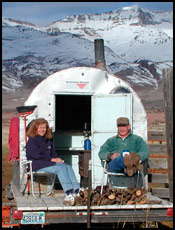
Ron Torell with his wife, Jackie.
Cow Camp Chatter
I have a beef about my beef purchase!
There is a growing popularity for consumer-direct sales of locally grown, grass-finished, hormone-free, all-natural freezer beef. Many consumers, however, are in the dark when it comes to understanding the yield loss of a 1,200-pound (lb.) grass-finished steer after harvesting. The entire steer carcass — cut and wrapped to specifications for a family of four — will fit into about eight cardboard boxes once it has been harvested, aged and processed. Baffled by this, consumers want to know what happened to the rest of their beef.
|
THE CONSUMER PURCHASED: |
|
| Live weight of one steer | 1,200 lb. |
| Drop, or offal (rumen fill, hide, internal organs, viscera) | -540 lb.
|
| Chilled carcass yield after drop/offal (55%-65% of live weight): | 660 lb. |
| Saw cutting loss of 1%-2% | -12 lb. |
| Trim and waste from bones, connective tissue, moisture, etc. | -171 lb.
|
| Estimated pounds of beef left for wrapping: | 477 lb. |
|
THE CONSUMER RECEIVED: |
||
| Retail cuts: | ||
| Steaks | 140 lb. | |
| Roasts | 119 lb. | |
| Brisket, miscellaneous cuts | 22 lb. | |
| Short ribs | 32 lb. | |
| Stew meat | 32 lb. | |
| Ground beef | 132 lb.
|
|
| Estimated pounds of cut & wrapped beef from 1,200-lb. live steer: | 477 lb. | |
In the above example, the consumer paid $1,440 for a 1,200-lb. live steer at $1.20 per pound. An additional $500 fee was incurred for harvesting, cutting, wrapping and transportation. After processing, the consumer received approximately 477 lb. of meat, resulting in a total cost of $4.06/lb. for what amounted to 40% of the original live weight. Where did the other 60% go? Disappointed with these numbers, the consumer felt cheated.
Understanding how the harvesting process works once the live steer is delivered to the plant is essential in order for consumers to walk away satisfied with their freezer beef purchase.
The drop, or offal, of an animal includes the rumen fill, hide and internal organs (or viscera) totaling roughly 40%-45% of a 1,200-lb. live steer. The majority of the offal value comes from the hide. The packing plant owns the drop/offal of the animal, which is generally valued between $7.00 and $14.00 per hundredweight (cwt.). This is used by the plant to offset packinghouse operating costs. The rumen fill stays on the harvest floor and has no value. Chilling the carcass for 24 hours and/or dry-aging hanging carcasses for an extended period of time (up to 14 days) in order to enhance tenderness and eating satisfaction results in a moisture loss of 1%-4% of the carcass. Generally there is also a 1%-2% saw cutting loss.
When purchasing a freezer beef, many consumers assume there will be more steaks, porterhouses and filet mignon; less hamburger; and few, if any, soup bones. They expect to have several tri-tips and none of the tough arm or chuck roasts. They fail to realize that there are a limited number of their favorite cuts from one beef animal. Ribeye and T-bone steaks originate from the rib and loin section of the carcass, which represents the most valuable portion of the animal — the middle meats.
As an industry, we seldom have a problem selling these middle meats, especially if the animal grades USDA Choice or higher. The quantity of middle meat steaks depends on the cutting specifications. If a rib roast is desired, then there won't be as many ribeye steaks. The filet mignon is the same muscle that makes up a good portion of porterhouse steaks, so consumers must decide which cut they prefer. A carcass has only two tri-tip roasts originating from the bottom sirloin. The top of the sirloin yields sirloin steaks and roasts.
Hamburger is a great outlet for trim and lower-valued muscle cuts that can't be marketed in other ways. Grinding hamburger also offers a place to market a portion of the fat waste that is inherent with fed cattle. Soup bones are essentially the same story.
It is unfortunate that other portions of the animal cannot be converted into equal quality and value as the middle meats. Our beef checkoff dollars, however, are working on doing just that. Through muscle profiling, value is being added to lower-end cuts such as the chuck, making this portion of the animal more palatable and desirable to the consumer.
The figures set forth in this article are used as an example only. Actual figures realized from other harvested animals may vary greatly depending upon animal conformation, frame size, degree of muscling, fat cover, age at harvest, sex of animal, cutting techniques and individual specifications. Grass-finished beef generally yields a lighter carcass in relation to live weight compared to beef on a grain-finish program. This is primarily due to the reduced amount of external fat cover on the grass-finished animal. When all is said and done, the consumer can expect to receive approximately 40% of edible product from a harvested grass-finished 1,200-lb. live steer.
That's enough for this month. A special thanks to my wife, Jackie, for her part in writing "Cow Camp Chatter." As always, if you would like to discuss this article or simply want to talk cows, do not hesitate to contact me at 775-385-7665 or e-mail me.
Editor's Note: The American Angus Association provides an "Angus Beef Chart" showing various cuts and where they come from, as well as recommended cooking methods. Click here to download the chart.











